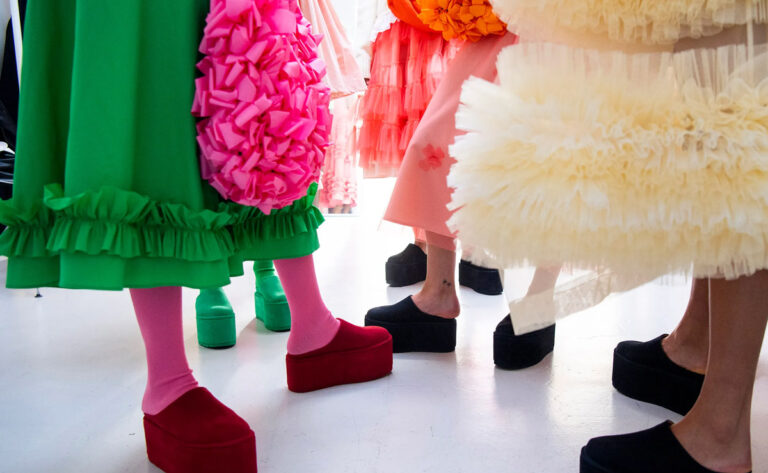Why are platform shoes making a soaring comeback?

As we begin to step out of lockdown fully and ease into the old normal, platform shoes have skyrocketed in popularity. Tracing the evolution of the ugly dad sneaker to the practical slip-ons and fluffy slippers sported during the peak of quarantine, the rise of the platform shoe seems to be inevitable. Whether it be a trainer, a sandal, a chunky formal shoe, or somewhere in between, the elevated style is certainly making a comeback. As we begin to re-enter our old stomping grounds, platforms allow us to do so with the accessibility and comfort we found in quintessential quarantine footwear while also boosting outfits’ wow-factor one step at a time.
Platforms offer more stability than soaring stilettos, while still allowing wearers to feel like the main character. Reflecting their eye-catching nature today, the shoe originated in 220 BC when ancient Greek actors would wear a similar style on stage to denote how central a character was. The footwear was adopted by many different regions and cultures for the next two millenniums, and first introduced to modern Western audiences with Salvatore Ferragamo’s iconic rainbow shoes. Initially designed for Judy Garland in 1938, the shoe captured the attention of fashion lovers for its multicoloured suede layers and dazzling gold straps. Since then, the style has been embraced by myriad designers, ranging in boldness and functionality.
In May 2021, Alice Newbold, Vogue.co.uk’s Senior News Editor, wrote an article following the trend’s emergence within Autumn/Winter 2021 collections across an array of brands. Fashion giants such as Loewe, Versace, Prada, and Simone Rocha have all taken to the trend, releasing their staggering renditions on catwalks and in campaigns recently. While towering platforms have always been a staple for fashion houses like Vivienne Westwood, the designer’s classic, sky-high Ghillie shoes have been making a comeback as well. First made famous by a fall by Naomi Campbell in the 90s, they have recently been spotted on Dua Lipa at the Brit Awards. While the average wearer isn’t reaching for these eye-wateringly high shoes for a night out, platforms of more conservative heights still grant their owners a bit of pep in their steps.
Of course, the most versatile, common iteration of the contemporary platform is the trainer. Boosted in popularity by the Spice Girls in the 90s, sneakers such as those from the legendary Buffalo brand, and others following in their footsteps, began gaining traction towards the end of the 2010s as the trendiness of the ballet flat began to die out. The platform trainer’s comfortable wearing experience paired with stand-out silhouettes have been adapted by seemingly everyone, finding potent examples in Eytys and Converse. Even Crocs has taken to the trend, expanding its demographic through a number of high-profile collaborations, the most famous rendition of which being Balenciaga’s 2017 take on the shoe.
While platforms can be viewed solely for their playful, emotive styles—especially as we begin to have collective fun again—the voices behind DietPrada have a different impression of the trend. Back in January, the famous trend-spotting and setting Instagram account invited its followers to think back to a time of Alexander McQueen’s nearly satirical ‘Armadillo’ boots and Lady Gaga’s countless red carpet appearances in gravity-defying shoes.
The time in question was the early 2010s, the period immediately following the financial crash of 2008. Elizabeth Semmelhack, Creative Director and Senior Curator of the Bata Shoe Museum in Toronto, has written extensively on the ebbs and flows of heels in all forms in her book Heights of Fashion: A History of the Elevated Shoe. In 2010, the expert told CNN that “we have entered a moment of heightened impracticality in footwear.” Referencing the rising trend of heels during the Great Depression in the 30s, the oil crisis in the 70s, and the aftermath of the dotcom bubble burst, the shoe historian notes that they could also represent “a greater need for escapism.”
That being said, the re-emergence of these attention-commanding footwear styles may not be signalling the beginning of another recession as DietPrada is suggesting. Instead, as we become acquainted with post-lockdown life, platforms can be seen as a spirited reaction to the past 18-or-so months of quarantine. Likewise, they can be viewed as a way of embracing the escapism now associated with the newly exuberant world outside of our homes. While embracing the fashion comforts and shortcuts most found with life at home, platforms also allow wearers to celebrate their footsteps on the tarmac, crowded tube platforms, and sticky dancefloors.




